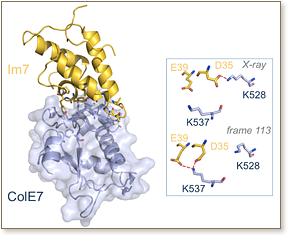
Molecular Dynamics (MD) simulations of protein complexes suffer from the lack of specific tools in the analysis step. Analyses of MD trajectories of protein complexes indeed generally rely on classical measures, such as the RMSD, RMSF and gyration radius, conceived and developed for single macromolecules. As a matter of fact, instead, researchers engaged in simulating the dynamics of a protein complex are mainly interested in characterizing the conservation/variation of its biological interface. On these bases, herein we propose a novel approach to the analysis of MD trajectories or other conformational ensembles of protein complexes, MDcons, which uses the conservation of inter-residue contacts at the interface as a measure of the similarity between different snapshots. A "consensus contact map" is also provided, where the conservation of the different contacts is drawn in a grey scale. Finally, the interface area of the complex is monitored during the simulations. To show its utility, we used this novel approach to study two protein-protein complexes with interfaces of comparable size and both dominated by hydrophilic interactions, but having binding affinities at the extremes of the experimental range. MDcons is demonstrated to be extremely useful to analyse the MD trajectories of the investigated complexes, adding important insight into the dynamic behavior of their biological interface. MDcons specifically allows the user to highlight and characterize the dynamics of the interface in protein complexes and can thus be used as a complementary tool for the analysis of MD simulations of both experimental and predicted structures of protein complexes.